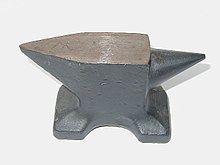Anvil
An anvil is a hard piece of metal which is used as a workbench when making things out of iron or steel. An anvil is used by a blacksmith when they need to hammer hot iron to bend it into the shape they want. A blacksmith can make new shoes for horses.

Anvils were known in the Bronze Age and possibly earlier. They were used in Ancient Greece and Ancient Egypt. They are still in use today, although not nearly as much as 100 years ago when there were many more horses.
Anvils are extremely heavy. They are made in different sizes. The 17th century writer John Bunyan was a tinker (someone who mends pots and pans). He walked around the villages of Bedfordshire with a small anvil and a few tools on his back. His anvil was wedge-shaped, so that he could knock it into the ground when he needed to do a repair. His anvil is now in the John Bunyan museum in Bedford.
Use as a musical instrument change
The anvil has sometimes been used as a percussion instrument because it makes a very loud sound when hit by the hammer. Usually musicians use a metal bar mounted on a sound-box. This sounds just as good as a real anvil (which would be very heavy to carry around).
Verdi wrote some famous music called the Anvil Chorus in his opera Il Trovatore. Wagner asked for 18 anvils in Das Rheingold in the scene which takes place below the earth where the Nibelungs are working at their forges. Albert Parlow wrote an Anvil Polka, Varèse used an anvil in Ionisation, Walton uses an anvil in Belshazzar’s Feast and there is an anvil in the orchestra in Howard Shore's music for The Lord of the Rings movie trilogy.